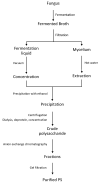Antioxidant Molecules from Marine Fungi: Methodologies and Perspectives
- PMID: 33256101
- PMCID: PMC7760651
- DOI: 10.3390/antiox9121183
Antioxidant Molecules from Marine Fungi: Methodologies and Perspectives
Abstract
The marine environment represents a prosperous existing resource for bioprospecting, covering 70% of the planet earth, and hosting a huge biodiversity. Advances in the research are progressively uncovering the presence of unknown microorganisms, which have evolved unique metabolic and genetic pathways for the production of uncommon secondary metabolites. Fungi have a leading role in marine bioprospecting since they represent a prolific source of structurally diverse bioactive metabolites. Several bioactive compounds from marine fungi have already been characterized including antibiotics, anticancer, antioxidants and antivirals. Nowadays, the search for natural antioxidant molecules capable of replacing those synthetic currently used, is an aspect that is receiving significant attention. Antioxidants can inactivate reactive oxygen and nitrogen species, preventing the insurgence of several degenerative diseases including cancer, autoimmune disorders, cardiovascular and neurodegenerative diseases. Moreover, they also find applications in different fields, including food preservation, healthcare and cosmetics. This review focuses on the production of antioxidants from marine fungi. We begin by proposing a survey of the available tools suitable for the evaluation of antioxidants, followed by the description of various classes of marine fungi antioxidants together with their extraction strategies. In addition, a view of the future perspectives and trends of these natural products within the "blue economy" is also presented.
Keywords: Antioxidants; applications; extraction protocols; fungi; marine natural products.
Conflict of interest statement
The authors declare no conflict of interest.
Figures


Similar articles
-
Marine Microbial-Derived Molecules and Their Potential Use in Cosmeceutical and Cosmetic Products.Mar Drugs. 2017 Apr 12;15(4):118. doi: 10.3390/md15040118. Mar Drugs. 2017. PMID: 28417932 Free PMC article. Review.
-
Antioxidant Secondary Metabolites From Marine-Derived Fungi: Chemical Diversity and Bioactivity Profiling.Chem Biodivers. 2025 Jun 16:e00901. doi: 10.1002/cbdv.202500901. Online ahead of print. Chem Biodivers. 2025. PMID: 40522782 Review.
-
Marine endophytic fungi associated with Halopteris scoparia (Linnaeus) Sauvageau as producers of bioactive secondary metabolites with potential dermocosmetic application.PLoS One. 2021 May 13;16(5):e0250954. doi: 10.1371/journal.pone.0250954. eCollection 2021. PLoS One. 2021. PMID: 33983974 Free PMC article.
-
Oxidative Stress and Marine Carotenoids: Application by Using Nanoformulations.Mar Drugs. 2020 Aug 13;18(8):423. doi: 10.3390/md18080423. Mar Drugs. 2020. PMID: 32823595 Free PMC article. Review.
-
Marine microorganisms as an untapped source of bioactive compounds.Saudi J Biol Sci. 2021 Jan;28(1):224-231. doi: 10.1016/j.sjbs.2020.09.052. Epub 2020 Oct 9. Saudi J Biol Sci. 2021. PMID: 33424301 Free PMC article. Review.
Cited by
-
Exploring the Potential of Using Marine-Derived Ingredients: From the Extraction to Cutting-Edge Cosmetics.Mar Drugs. 2023 Nov 29;21(12):620. doi: 10.3390/md21120620. Mar Drugs. 2023. PMID: 38132941 Free PMC article. Review.
-
Microorganisms: A Potential Source of Bioactive Molecules for Antioxidant Applications.Molecules. 2021 Feb 20;26(4):1142. doi: 10.3390/molecules26041142. Molecules. 2021. PMID: 33672774 Free PMC article. Review.
-
Marine Natural Products: Promising Candidates in the Modulation of Gut-Brain Axis towards Neuroprotection.Mar Drugs. 2021 Mar 19;19(3):165. doi: 10.3390/md19030165. Mar Drugs. 2021. PMID: 33808737 Free PMC article. Review.
-
Fungi as veritable tool in current advances in nanobiotechnology.Heliyon. 2021 Nov 25;7(11):e08480. doi: 10.1016/j.heliyon.2021.e08480. eCollection 2021 Nov. Heliyon. 2021. PMID: 34901509 Free PMC article. Review.
-
Assessment of the photoprotective potential and structural characterization of secondary metabolites of Antarctic fungus Arthrinium sp.Arch Microbiol. 2023 Dec 23;206(1):35. doi: 10.1007/s00203-023-03756-w. Arch Microbiol. 2023. PMID: 38141073
References
-
- Lauritano C., Ianora A. Grand Challenges in Marine Biotechnology. Springer; Berlin/Heidelberg, Germany: 2018. Grand Challenges in Marine Biotechnology: Overview of Recent EU-Funded Projects; pp. 425–449.
-
- Giordano D., Coppola D., Russo R., Denaro R., Giuliano L., Lauro F.M., di Prisco G., Verde C. Marine Microbial Secondary Metabolites: Pathways, Evolution and Physiological Roles. Adv. Microb. Physiol. 2015;66:357–428. - PubMed
Publication types
Grants and funding
LinkOut - more resources
Full Text Sources

